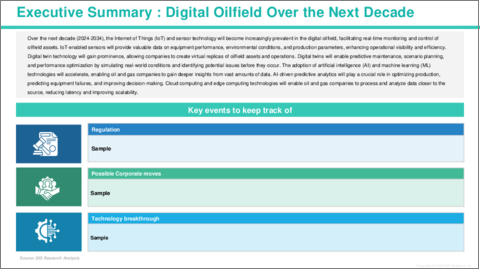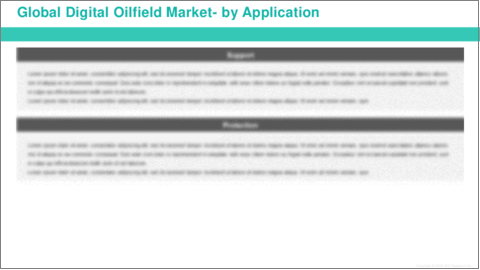|
|
市場調査レポート
商品コード
1470374
デジタル油田の世界市場:用途・ソリューション・プロセス・地域別の分析・予測 (2024-2034年)Global Digital Oilfield Market: Focus on Application, Solution, Process, and Region - Analysis and Forecast, 2024-2034 |
||||||
カスタマイズ可能
|
|||||||
| デジタル油田の世界市場:用途・ソリューション・プロセス・地域別の分析・予測 (2024-2034年) |
|
出版日: 2024年04月26日
発行: BIS Research
ページ情報: 英文 100 Pages
納期: 1~5営業日
|
- 全表示
- 概要
- 目次
デジタル油田の市場は、デジタル技術の継続的な進歩、運用コストの削減、生産の最適化、効率の改善、持続可能性の重視の高まりなどに後押しされ、大きな成長を遂げています。
楽観的シナリオでは、2024年の市場規模は366億5,000万米ドルを示し、CAGR 6.11%で推移し、2034年には663億1,000万米ドルの規模に成長すると予測されています。
| 主要市場統計 | |
|---|---|
| 予測期間 | 2024-2034年 |
| 2024年評価 | 366億5,000万米ドル |
| 2034年予測 | 663億1,000万米ドル |
| CAGR | 6.11% |
こうした市場促進要因にもかかわらず、同市場は技術、インフラ、トレーニングへの多額の初期投資といったハードルに直面しています。しかし、リアルタイムの洞察と実用的なインテリジェンスに対する需要の高まりは、デジタル油田需要の拡大に有利な機会を提示しており、データプライバシー、セキュリティ、サイバー脅威に対する懸念の高まりという課題を克服しながら、この市場の活気ある将来を示唆しています。
北米には、デジタル油田技術開発の最前線に立つ大手技術企業や研究機関が多数存在します。データアナリティクス、AI、IoTなどの分野における革新により、石油・ガス事業から膨大な量のデータを収集、分析、解釈することが可能になっています。北米では、パイプライン、製油所、生産施設など、石油・ガスインフラに多額の投資が行われています。デジタル油田技術は、これらの資産の信頼性、安全性、効率を向上させ、性能を最適化し、寿命を延ばします。
当レポートでは、世界のデジタル油田の市場を調査し、業界の動向、法規制環境、使用事例、市場規模の推移・予測、各種区分・地域/主要国別の詳細分析、競合情勢、主要企業のプロファイルなどをまとめています。
目次
エグゼクティブサマリー
第1章 市場:業界の展望
- 動向:現在および将来の影響評価
- サプライチェーンの概要
- バリューチェーン分析
- 価格予測
- 規制状況
- ステークホルダー分析
- 使用事例
- エンドユーザーと購入基準
- 主要な世界的イベントの影響分析
- 市場力学の概要
- 市場促進要因
- 市場抑制要因
- 市場機会
第2章 デジタル油田市場:用途別
- 用途の分類
- 用途の概要
- デジタル油田市場:用途別
- オフショア
- オンショア
- デジタル油田市場:プロセス別
- 生産の最適化
- 貯水池管理
- 掘削の最適化
- 安全管理
- その他
第3章 デジタル油田市場:製品別
- 製品の分類
- 製品概要
- デジタル油田市場:ソリューション別
- ハードウェア
- ソフトウェア・サービス
- データストレージソリューション
第4章 世界のデジタル油田市場:地域別
- デジタル油田市場:地域別
- 北米
- 欧州
- アジア太平洋
- 南米
- 中東・アフリカ
第5章 企業プロファイル
- 次なるフロンティア
- 地理的評価
- ABB
- Baker Hughes Company
- CGG
- Digi International Inc.
- Emerson Electric Co.
- Halliburton
- Honeywell International Inc.
- IBM
- Kongsberg Digital
- Pason Systems Corp.
- PETRO.ai.
- Schneider Electric
- Siemens AG
- SLB
- Weatherford
- その他
第6章 調査手法
Introduction to Digital Oilfield Market
Digital oilfield market is experiencing significant growth, propelled by continuous advancements in digital technologies, reduce operational costs, optimized production, and improved efficiency, and increasing emphasis on sustainability. Considering the optimistic scenario the market is valued at $36.65 Billion in 2024 and is expected to grow at a CAGR of 6.11% to reach $66.31 billion by 2034.
| KEY MARKET STATISTICS | |
|---|---|
| Forecast Period | 2024 - 2034 |
| 2024 Evaluation | $36.65 Billion |
| 2034 Forecast | $66.31 Billion |
| CAGR | 6.11% |
Despite these positive drivers, the market faces hurdles such as significant initial investment in technology, infrastructure, and training. However, increasing demand for real-time insights and actionable intelligencepresent lucrative opportunities for the expansion of digital oilfield demand, suggesting a vibrant future for this market as it navigates through challenges towards rising concerns about data privacy, security, and cyber threats.
North America is home to many leading technology companies and research institutions that are at the forefront of developing digital oilfield technologies. Innovations in areas such as data analytics, artificial intelligence, and IoT have enabled the industry to collect, analyze, and interpret vast amounts of data from oil and gas operations. North America has significant investments in oil and gas infrastructure, including pipelines, refineries, and production facilities. Digital oilfield technologies improve the reliability, safety, and efficiency of these assets, optimizing their performance and extending their lifespan.
Companies such as SLB and Baker huges plays a crucial role in shaping the digital oilfield market globally, offering a wide range of technology solutions tailored for the oil and gas industry. These solutions include drilling optimization software, real-time data analytics platforms, reservoir modeling software, and integrated field management systems.
The rising focus on autonomous operations in the oil and gas industry is driven by a desire to minimize human exposure to hazardous conditions, improve safety performance, and enhance operational efficiency. Autonomous operations reduce the need for human intervention in hazardous environments, such as offshore platforms, well sites, and refineries, thereby mitigating the risk of accidents, injuries, and fatalities. By replacing manual tasks with automated systems and robotics, companies can improve safety performance and create safer working environments for employees. In May 2023, Rockwell Automation disclosed its collaboration with TotalEnergies to deploy a robot fleet management system, aimed at advancing autonomous operations for its offshore platforms. This enduring project is poised to achieve a significant milestone with its inaugural test on an offshore asset scheduled for mid-2023. Energy companies are increasingly investing in robotics technology within their facilities, with the objective of facilitating unmanned operations for extended durations. This strategic investment serves multiple purposes, including minimizing employee exposure to hazardous situations, enhancing safety protocols, attracting younger talent intrigued by cutting-edge technologies, and driving down both capital and operational expenditures.
Market Segmentation:
Segmentation 1: by Application
- Offshore
- Onshore
Segmentation 2: by Process
- Production Optimization
- Reservoir Management
- Drilling Optimization
- Safety Management
- Others
Segmentation 3: by Solution
- Hardware
- Software and Service
- Data Storage Solutions
Segmentation 4: by Region
- North America
- Europe
- Asia-Pacific
- South America
- Middle East and Africa
Key Market Players and Competition Synopsis
The companies that are profiled in the global digital oilfield market have been selected based on input gathered from primary experts and analyzing company coverage, product portfolio, and market penetration.
Some of the prominent companies in this market are:
- Halliburton
- Baker Hughes Company
- Weatherford
- SLB
Key Questions Answered in this Report:
- What are the main factors driving the demand for digital oilfield market?
- What are the major patents filed by the companies active in the global digital oilfield market?
- Who are the key players in the global digital oilfield market, and what are their respective market shares?
- What partnerships or collaborations are prominent among stakeholders in the global digital oilfield market?
- What are the strategies adopted by the key companies to gain a competitive edge in digital oilfield industry?
- What is the futuristic outlook for the digital oilfield market in terms of growth potential?
- What is the current estimation of the global digital oilfield market, and what growth trajectory is projected from 2024 to 2034?
- Which application, and product segment is expected to lead the market over the forecast period (2024-2034)?
- What could be the impact of growing end-use industries in the global digital oilfield market?
- Which regions demonstrate the highest adoption rates for global digital oilfield market, and what factors contribute to their leadership?
Table of Contents
Executive Summary
Scope and Definition
Market/Product Definition
Key Questions Answered
Analysis and Forecast Note
1. Markets: Industry Outlook
- 1.1 Trends: Current and Future Impact Assessment
- 1.2 Supply Chain Overview
- 1.2.1 Value Chain Analysis
- 1.2.2 Pricing Forecast
- 1.3 Regulatory Landscape
- 1.4 Stakeholder Analysis
- 1.4.1 Use Case
- 1.4.2 End User and Buying Criteria
- 1.5 Impact Analysis for Key Global Events
- 1.6 Market Dynamics Overview
- 1.6.1 Market Drivers
- 1.6.2 Market Restraints
- 1.6.3 Market Opportunities
2. Digital Oilfield Market (by Application)
- 2.1 Application Segmentation
- 2.2 Application Summary
- 2.3 Digital Oilfield Market (by Application)
- 2.3.1 Offshore
- 2.3.2 Onshore
- 2.4 Digital Oilfield Market (by Process)
- 2.4.1 Production Optimization
- 2.4.2 Reservoir Management
- 2.4.3 Drilling Optimization
- 2.4.4 Safety Management
- 2.4.5 Others
3. Digital Oilfield Market (by Product)
- 3.1 Product Segmentation
- 3.2 Product Summary
- 3.3 Digital Oilfield Market (by Solution)
- 3.3.1 Hardware
- 3.3.2 Software and Service
- 3.3.3 Data Storage Solutions
4. Global Digital Oilfield Market (by Region)
- 4.1 Digital Oilfield Market (by Region)
- 4.2 North America
- 4.2.1 Regional Overview
- 4.2.2 Driving Factors for Market Growth
- 4.2.3 Factors Challenging the Market
- 4.2.4 Application
- 4.2.5 Product
- 4.2.6 U.S.
- 4.2.6.1 Market by Application
- 4.2.6.2 Market by Product
- 4.2.7 Canada
- 4.2.7.1 Market by Application
- 4.2.7.2 Market by Product
- 4.2.8 Mexico
- 4.2.8.1 Market by Application
- 4.2.8.2 Market by Product
- 4.3 Europe
- 4.3.1 Regional Overview
- 4.3.2 Driving Factors for Market Growth
- 4.3.3 Factors Challenging the Market
- 4.3.4 Application
- 4.3.5 Product
- 4.3.6 Norway
- 4.3.6.1 Market by Application
- 4.3.6.2 Market by Product
- 4.3.7 Russia
- 4.3.7.1 Market by Application
- 4.3.7.2 Market by Product
- 4.3.8 U.K.
- 4.3.8.1 Market by Application
- 4.3.8.2 Market by Product
- 4.3.9 Rest-of-Europe
- 4.3.9.1 Market by Application
- 4.3.9.2 Market by Product
- 4.4 Asia-Pacific
- 4.4.1 Regional Overview
- 4.4.2 Driving Factors for Market Growth
- 4.4.3 Factors Challenging the Market
- 4.4.4 Application
- 4.4.5 Product
- 4.4.6 China
- 4.4.6.1 Market by Application
- 4.4.6.2 Market by Product
- 4.4.7 Australia
- 4.4.7.1 Market by Application
- 4.4.7.2 Market by Product
- 4.4.8 Malaysia
- 4.4.8.1 Market by Application
- 4.4.8.2 Market by Product
- 4.4.9 Indonesia
- 4.4.9.1 Market by Application
- 4.4.9.2 Market by Product
- 4.4.10 Rest-of-Asia-Pacific
- 4.4.10.1 Market by Application
- 4.4.10.2 Market by Product
- 4.5 South America
- 4.5.1 Regional Overview
- 4.5.2 Driving Factors for Market Growth
- 4.5.3 Factors Challenging the Market
- 4.5.4 Application
- 4.5.5 Product
- 4.5.6 Brazil
- 4.5.6.1 Market by Application
- 4.5.6.2 Market by Product
- 4.5.7 Rest-of-South America
- 4.5.7.1 Market by Application
- 4.5.7.2 Market by Product
- 4.6 Middle East and Africa
- 4.6.1 Regional Overview
- 4.6.2 Driving Factors for Market Growth
- 4.6.3 Factors Challenging the Market
- 4.6.4 Application
- 4.6.5 Product
- 4.6.6 Saudi Arabia
- 4.6.6.1 Market by Application
- 4.6.6.2 Market by Product
- 4.6.7 U.A.E.
- 4.6.7.1 Market by Application
- 4.6.7.2 Market by Product
- 4.6.8 Kuwait
- 4.6.8.1 Market by Application
- 4.6.8.2 Market by Product
- 4.6.9 Rest-of-Middle East and Africa
- 4.6.9.1 Market by Application
- 4.6.9.2 Market by Product
5. Companies Profiled
- 5.1 Next Frontiers
- 5.2 Geographic Assessment
- 5.2.1 ABB
- 5.2.1.1 Overview
- 5.2.1.2 Top Products/Product Portfolio
- 5.2.1.3 Top Competitors
- 5.2.1.4 Target Customers
- 5.2.1.5 Key Personnel
- 5.2.1.6 Analyst View
- 5.2.1.7 Market Share
- 5.2.2 Baker Hughes Company
- 5.2.2.1 Overview
- 5.2.2.2 Top Products/Product Portfolio
- 5.2.2.3 Top Competitors
- 5.2.2.4 Target Customers
- 5.2.2.5 Key Personnel
- 5.2.2.6 Analyst View
- 5.2.2.7 Market Share
- 5.2.3 CGG
- 5.2.3.1 Overview
- 5.2.3.2 Top Products/Product Portfolio
- 5.2.3.3 Top Competitors
- 5.2.3.4 Target Customers
- 5.2.3.5 Key Personnel
- 5.2.3.6 Analyst View
- 5.2.3.7 Market Share
- 5.2.4 Digi International Inc.
- 5.2.4.1 Overview
- 5.2.4.2 Top Products/Product Portfolio
- 5.2.4.3 Top Competitors
- 5.2.4.4 Target Customers
- 5.2.4.5 Key Personnel
- 5.2.4.6 Analyst View
- 5.2.4.7 Market Share
- 5.2.5 Emerson Electric Co.
- 5.2.5.1 Overview
- 5.2.5.2 Top Products/Product Portfolio
- 5.2.5.3 Top Competitors
- 5.2.5.4 Target Customers
- 5.2.5.5 Key Personnel
- 5.2.5.6 Analyst View
- 5.2.5.7 Market Share
- 5.2.6 Halliburton
- 5.2.6.1 Overview
- 5.2.6.2 Top Products/Product Portfolio
- 5.2.6.3 Top Competitors
- 5.2.6.4 Target Customers
- 5.2.6.5 Key Personnel
- 5.2.6.6 Analyst View
- 5.2.6.7 Market Share
- 5.2.7 Honeywell International Inc.
- 5.2.7.1 Overview
- 5.2.7.2 Top Products/Product Portfolio
- 5.2.7.3 Top Competitors
- 5.2.7.4 Target Customers
- 5.2.7.5 Key Personnel
- 5.2.7.6 Analyst View
- 5.2.7.7 Market Share
- 5.2.8 IBM
- 5.2.8.1 Overview
- 5.2.8.2 Top Products/Product Portfolio
- 5.2.8.3 Top Competitors
- 5.2.8.4 Target Customers
- 5.2.8.5 Key Personnel
- 5.2.8.6 Analyst View
- 5.2.8.7 Market Share
- 5.2.9 Kongsberg Digital
- 5.2.9.1 Overview
- 5.2.9.2 Top Products/Product Portfolio
- 5.2.9.3 Top Competitors
- 5.2.9.4 Target Customers
- 5.2.9.5 Key Personnel
- 5.2.9.6 Analyst View
- 5.2.9.7 Market Share
- 5.2.10 Pason Systems Corp.
- 5.2.10.1 Overview
- 5.2.10.2 Top Products/Product Portfolio
- 5.2.10.3 Top Competitors
- 5.2.10.4 Target Customers
- 5.2.10.5 Key Personnel
- 5.2.10.6 Analyst View
- 5.2.10.7 Market Share
- 5.2.11 PETRO.ai.
- 5.2.11.1 Overview
- 5.2.11.2 Top Products/Product Portfolio
- 5.2.11.3 Top Competitors
- 5.2.11.4 Target Customers
- 5.2.11.5 Key Personnel
- 5.2.11.6 Analyst View
- 5.2.11.7 Market Share
- 5.2.12 Schneider Electric
- 5.2.12.1 Overview
- 5.2.12.2 Top Products/Product Portfolio
- 5.2.12.3 Top Competitors
- 5.2.12.4 Target Customers
- 5.2.12.5 Key Personnel
- 5.2.12.6 Analyst View
- 5.2.12.7 Market Share
- 5.2.13 Siemens AG
- 5.2.13.1 Overview
- 5.2.13.2 Top Products/Product Portfolio
- 5.2.13.3 Top Competitors
- 5.2.13.4 Target Customers
- 5.2.13.5 Key Personnel
- 5.2.13.6 Analyst View
- 5.2.13.7 Market Share
- 5.2.14 SLB
- 5.2.14.1 Overview
- 5.2.14.2 Top Products/Product Portfolio
- 5.2.14.3 Top Competitors
- 5.2.14.4 Target Customers
- 5.2.14.5 Key Personnel
- 5.2.14.6 Analyst View
- 5.2.14.7 Market Share
- 5.2.15 Weatherford
- 5.2.15.1 Overview
- 5.2.15.2 Top Products/Product Portfolio
- 5.2.15.3 Top Competitors
- 5.2.15.4 Target Customers
- 5.2.15.5 Key Personnel
- 5.2.15.6 Analyst View
- 5.2.15.7 Market Share
- 5.2.16 Others
- 5.2.1 ABB






